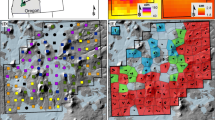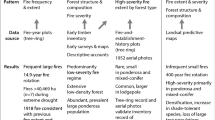Abstract
A key issue in ecosystem management in the western U.S. is the determination of the historic range of variability of fire and its ecological significance prior to major land-use changes associated with Euro-American settlement. The present study relates spatial variation in historical fire occurrence to variation in abiotic and biotic predictors of fire frequency and severity across the elevational range of ponderosa pine in northern Colorado. Logistic regression was used to relate fire frequency to environmental predictors and to derive a probability surface for mapping purposes. These results indicate that less than 20% of the ponderosa pine zone had an historic fire regime (pre-1915) of relatively frequent fires (mean fire intervals, MFI, <30 years). More than 80% is reconstructed to have had a lower frequency (MFI ≥ 30 years), more variable severity fire regime. High fire frequency is clearly associated with low elevations. Lower and more variable fire frequencies, associated with high and moderate severities, occur across a broad range of elevation and are related to variations in other environmental variables. Only a small part of the ponderosa pine zone fits the widespread view that the historic fire regime was characterized mainly by frequent, low-severity that maintained open conditions. Management attempts to restore historic forest structures and/or fire conditions must recognize that infrequent severe fires were an important component of the historic fire regime in this cover type in northern Colorado.




Similar content being viewed by others
References
Allen CD, Savage M, Falk DA, Suckling KF, Swetnam TW, Schulke T, Stacey PB, Morgan P, Hoffman M, Klingel JT. 2002. Ecological restoration of southwestern ponderosa pine ecosystems: A broad perspective. Ecol Appl 12:1418–33
Arno SF, Scott JH, Hartwell MG. 1995. Age-class structure of old growth ponderosa pine/Douglas-fir stands and its relationship to fire history. USDA Forest Service, Research Paper INT-481
Baker WL, Ehle D. 2001. Uncertainty in surface-fire history: the case of ponderosa pine forest in the Western United States. Can J For Res 31:1205–26
Barrett SW, Arno SE. 1988. Increment-borer methods for determining history in coniferous forests. USDA Forest Service, General Technical Report INT-244
Brown PM, Kaufmann MR, Shepperd WD. 1999. Long-term, landscape patterns of past fire events in a montane ponderosa pine forest of central Colorado. Landsc Ecol 4:513–32
Covington WW. 2000. Helping western forests heal. Nature 408:135–6
Covington WW, Fule PZ, Moore MM, Hart SC, Kolb TE, Mast JN, Sackett SS, Wagner MR. 1997. Restoring ecosystem health in ponderosa pine forests of the southwest. J For 95:23–9
De’ath G, Fabricius KE. 2000. Classification and regression trees: a powerful yet simple technique for ecological data analysis. Ecology 81:3178–92
Ehle DS, Baker WL. 2003. Disturbance and stand dynamics in ponderosa pine forests in Rocky Mountain National Park, USA. Ecol Monogr 73:543–66
Fieldling AH, Bell JF. 1997. A review of methods for assessment of prediction errors in conservation presence/absence models. Environ Conserv 24:38–49
Finney MA, Bartlette R, Bradshaw L, Close K, Collins BM, Gleason P, Hao WM, Langowski P, McGinely J, McHugh CW, Martinson E, Omi PN, Sheppard W, Zeller K. 2003. Fire behavior, fuel treatments, and fire suppression on the Hayman Fire. In: Graham RT, Ed. Hayman fire case study analysis. USDA Forest Service, General Technical Report RMRS-GTR-114. pp 59–96
Franklin J. 1995. Predictive vegetation mapping: geographic modeling of biospatial patterns in relation to environmental gradients. Prog Phys Geogr 19:474–99
Franklin J. 1998. Predicting the distribution of shrub species in southern California from climate and terrain-derived variables. J Veg Sci 9:733–48
Franklin J. 2002. Enhancing a regional vegetation map with predictive models of dominant plant species in chaparral. Appl Veg Sci 5:135–46
Fule PZ, Covington WW, Moore MM. 1997. Determining reference conditions for ecosystem management of southwestern ponderosa pine forests. Ecol Appl 7:895–908
Goldblum D, Veblen TT. 1992. Fire history of a ponderosa pine/Douglas fir forest in the Colorado Front Range. Phys Geogr 13:133–48
Gruell GE. 1983. Fire and vegetative trends in the northern rockies: interpretations from 1871–1982 photographs. USDA Forest Service, General Technical Report RMRS-GTR-115
Guisan A, Zimmermann NE. 2000. Predictive habitat distribution models in ecology. Ecol Modell 135:147–86
Gutsell SL, Johnson EA, Miyanishi K, Keeley JE, Dickinson M, Bridges SRJ. 2001. Varied ecosystems need different fire protection. Nature 409:997.
Healthy Forests Restoration Act. HR 1904. 2003. http://www.whitehouse.gov/infocus/healthyforests
Hosmer DW, Lemeshow S. 2000. Applied logistic regression, 2nd edn. New York: Wiley
Jenson SK, Domingue JO. 1988. Extracting topographic structure from digital elevation data for geographic information system analysis. Photogramm Eng Remote Sens 54:1593–600
Kaufmann MR, Regan CM, Brown PM. 2000. Heterogeneity in ponderosa pine/Douglas-fir forests: age and size structure in unlogged and logged landscapes of central Colorado. Can J For Res 30:698–711
Liu C, Berry PM, Dawson TP, Pearson RG. 2005. Selecting thresholds of occurrence in the prediction of species distributions. Ecography 28:385–93
Manel S, Williams HC, Ormerod SJ. 2001. Evaluating presence-absence models in ecology: the need to account for prevalence. J Appl Ecol 38:921–31
Marr JW. 1961. Ecosystems of the east slope of the Front Range in Colorado. University of Colorado Studies Series in Biology 8, Boulder, Colorado
Mast JN, Fule PZ, Moore MM, Covington WW, Waltz AEM. 1999. Restoration of presettlement age structure of an Arizona ponderosa pine forest. Ecol Appl 9:228–39
Mast JN, Veblen TT, Linhart YB. 1998. Disturbance and climatic influences on age structure of ponderosa pine at the pine/grassland ecotone, Colorado Front Range. J Biogeogr 25:743–55
Miller J, Franklin J. 2002. Modelling the distribution of four vegetation alliances using generalized linear models and classification trees with spatial dependence. Ecol Modell 157:227–47
Peet RK. 1981. Forest vegetation of the Colorado Front Range: composition and dynamics. Vegetatio 45:3–75
Schoennagel T, Veblen TT, Romme WH. 2004. The interaction of fire, fuels, and climate across Rocky Mountain Forests. Bioscience 54:661–76
Sherriff RL. 2004. The historic range of variability of ponderosa pine in the northern Colorado Front Range: past fire types and fire effects. Ph.D. Dissertation. Boulder: University of Colorado
Sherriff RL, Veblen TT. 2006. Ecological effects of changes in fire regimes in Pinus ponderosa ecosystems in the Colorado Front Range. J Veg Sci 17:705–718
Shinneman DJ, Baker WL. 1997. Nonequilibrium dynamics between catastrophic disturbance and old-growth forests in ponderosa pine landscapes of the Black Hills. Conserv Biol 11:1276–88
Swetnam TW, Baisan CH. 1996. Historical fire regime patterns in the southwestern United States since AD 1700. In: Allen CD, Ed. Proceedings of the 2nd annual La Mesa fire symposium. USDA Forest Service General Technical Report RM-GTR-286
Veblen TT. 2003a. Historic range of variability of mountain forest ecosystems: concepts and applications. For Chron 79:223–6
Veblen TT. 2003b. An introduction to key issues in fire regime research for fuels management and ecological restoration. In: Omi P, Joyce L, Eds. Fire, fuel treatments and ecological restoration: conference proceedings 2002, 16–18 April, Fort Collins, CO. USDA, Forest Service, RMRS-P-29
Veblen TT, Kitzberger T, Donnegan J. 1996. A Research Report to the City of Boulder Open Space: Fire Ecology in the Wildland/Urban Interface of Boulder County. Unpublished manuscript
Veblen TT, Kitzberger T, Donnegan J. 2000. Climatic and human influences on fire regimes in ponderosa pine forests in the Colorado Front Range. Ecol Appl 10:1178–95
Veblen TT, Lorenz DC. 1986. Anthropogenic disturbance and recovery patterns in montane forests, Colorado Front Range. Phys Geogr 7:1–24
Veblen TT, Lorenz DC. 1991. The Colorado Front Range: a century of ecological change. Salt Lake City (UT): University of Utah Press
Wilson JP, Gallant JC. 2000. Terrain analysis: principles and applications. New York: Wiley
Zweig MH, Campbell G. 1993. Receiver-operating characteristic (ROC) plots: a fundamental evaluation tool in clinical medicine. Clin Chem 39:561–77
Acknowledgments
Research was funded by the City of Boulder Department of Open Space, Boulder County Open Space, the U.S.G.S Division of Biological Resources, the National Science Foundation (awards DEB-0314305 and BCS-0221493), the Biogeography Specialty Group (AAG), the Colorado Mountain Club Foundation, the SURE and UROP Programs of CU, the G.F. White Fellowship Program, the M. Duncan Memorial Scholarship Program, the E.B. Sussman Environmental Internship Program, the J.W. Marr Memorial Ecology Fund, the CU Graduate School and the Herbarium. For commenting on drafts of the manuscript we thank B. Buttenfield, R. Platt and T. Schoennagel, J. Clark, M. Turner and two anonymous reviewers. For field assistance we thank E. Brignull, M. Chatham, S. Dykes, B. Easley, K. Eisenhart, D. Goldstein, D. Heigele, D. Kulakowski, K. League, D. Manthorne, T. Overton, S. Rynders, D. Seidman, J. Sibold, and A. Whitmer.
Author information
Authors and Affiliations
Corresponding author
Rights and permissions
About this article
Cite this article
Sherriff, R.L., Veblen, T.T. A Spatially-Explicit Reconstruction of Historical Fire Occurrence in the Ponderosa Pine Zone of the Colorado Front Range. Ecosystems 10, 311–323 (2007). https://doi.org/10.1007/s10021-007-9022-2
Received:
Accepted:
Published:
Issue Date:
DOI: https://doi.org/10.1007/s10021-007-9022-2




